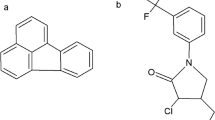Abstract
Effect of low (5 mmol·dm−3) and high (10 or 20 mmol·dm−3) doses of 1.10-phenanthroline (Phe), a photodynamic herbicide, on the development of chloroplasts in etiolated and subsequently illuminated maize seedlings and on the structure of already developed chloroplasts of green maize seedlings was examined. Etiolated and then irradiated plants were resistant to 5 mmol·dm−3 of Phe with respect to morphology, however Phe caused inhibition of greening and of grana formation. Higher Phe concentrations followed by exposure to light caused not only total inhibition of greening but also dilation of thylakoids, swelling of chloroplasts, and finally total destruction of chloroplast structure. Application of Phe in the same concentrations to green plants revealed that they were resistant to low dose of Phe with respect to morphology and structure of chloroplasts, however 10 and 20 mmol·dm−3 Phe and illumination caused the loss of turgor of treated plants and other photooxidative damages seen at the ultrastructural level. We concluded that maize, as representant of monocotyledonous plants, is resistant to low (5 mmol·dm−3) Phe concentration. Higher (10 or 20 mmol·dm−3) concentrations, used to determine the site of damage and mode of action of Phe on the level of cell revealed that action of photodynamic herbicides is based on standard photoinhibition mechanism and also probably on their chelating properties.
Similar content being viewed by others
Abbreviations
- ALA:
-
δ -aminolevulinic acid
- 2,2′-B:
-
2,2′-bipyridyl
- Car:
-
carotenoid
- Chl:
-
chlorophyll
- ER:
-
endoplasmic reticulum
- 8H:
-
8-hydroxyquinoline
- LHCP:
-
light-harvesting Chl a/b-binding proteins
- Phe:
-
1,10-phenanthroline
- PS II:
-
photosystem II
- PBs:
-
prolamellar bodies
References
Averina N.G., Shalygo N.V., Yaronskaya V., Rassadina V. 1988. Photodynamic effect and porphyrin accumulation in plants pretreated with δ-aminolevulinic acid and a,a′-dipyridyl. Fizjol. Rast. 35: 679–686.
Averina N.G., Shalygo N.V., Yaronskaya V. 1989. Effect of glutamic acid and 1,10-phenanthroline on the accumulation of chlorophyll precursors in green Phaseolus leaves. Photosynthetica 23: 383–385.
Carey E.E., Rebeiz C.A. 1985. Chloroplast biogenesis 49. Differences among Angiosperms in the biosynthesis and accumulation of monovinyl and divinyl protochlorophyllide during photoperiodic greening. Plant Physiol. 79: 1–6.
Carey E.E., Tripathy B.C., Rebeiz C.A. 1985. Chloroplast biogenesis 51. Modulation of monovinyl and divinyl protochlorophyllide biogenesis by light and darkness in vitro. Plant Physiol. 79: 1059–1063.
Dodge A.D., Knox J.P. 1986. Photosensitizers from plants. Pesticide Science 17: 579–586
Duggan J., Gassman M. 1974. Induction of porphyrin synthesis in etiolated bean leaves by chelators of iron. Plant Physiol. 53: 206–215.
Duke S.O., Becerril J.M., Sherman T.D., Matsumoto H. 1991. Photosensitizing porphyrins as herbicides. In: Naturally occurring pest bioregulators. ed. by A. Hedin A, American Chemical Society: 371–386.
Hendry G.A.F., Stobart A.K. 1978. Effect of 2.2′-dipyridyl on porphyrin synthesis in etiolated and light-treated barley leaves. Phytochemistry 17: 671–674.
Kittsteiner U., Mostowska A., Malinowski H., Rüdiger W. 1990. Influence of 5-aminolevulinate and complexing agents upon chlorophyll accumulation. In: Current Research in Photosynthesis. Vol. 3. ed. by M. Baltscheffsky, Kluwer, Utrecht: 679–682.
Kittsteiner U., Mostowska A., Rüdiger W. 1991. The greening process in cress seedlings I. Pigment accumulation and ultrastructure after application of 5-aminolevulinate and complexing agents. Physiol. Plant. 81: 139–147.
Mayasich J.M., Mayasich S.A., Rebeiz C.A. 1990. Response of corn (Zea mays), soybean (Glycine max), and several weed species to dark-applied photodynamic herbicide modulators. Weed Sci. 38: 10–15.
Mostowska A., Kittsteiner U., Rüdiger W. 1991a. Effect of 1,10-phenanthroline on ultrastructure of pea leaves. Protoplasma 161: 23–30.
Mostowska A., Fiett D., Parys E. 1991b. Influence of 1,10-phenanthroline — a photodynamic herbicide, on the ultrastructure of mesophyll cells and photosynthetic activity in greening pea seedlings. Env. Exp. Bot. 31: 385–395.
Mostowska A., Siedlecka M. 1995. Influence of 2.2′-bipyridyl, a photodynamic herbicide, on chloroplast development and pigment content in etiolated pea seedlings. Acta Physiol. Plant. 17: 21–30.
Mostowska A., Siedlecka M., Parys E. 1996. Effect of 2.2′-bipyridyl, a photodynamic herbicide, on chloroplast ultrastructure, pigment content and photosynthesis rate in pea seedlings. Acta Physiol. Plant. 18: 153–164.
Portis A.R. Jr. 1992. Regulation of ribulose 1,5-bisphospate carboxylase/oxygenase activity. Annu. Rev. Plant Physiol. Plant Mol. Biol. 43: 415–437.
Rebeiz C.A., Montazer-Zouhoor A., Hopen H.J., Wu S.M. 1984. Photodynamic herbicides: 1. Concept and phenomenology. Enzyme Microbiol. Technol. 6: 390–401.
Rebeiz C.A., Montazer-Zouhoor A., Mayasich J.M., Tripathy B.C., Wu S.M., Rebeiz C.C. 1988. Photodynamic herbicides. Recent developments and molecular basis of selectivity. In: Critical Reviews in Plant Sciences. Vol. 6, ed. by B.V. Conger, CRC Press Inc. Boca Raton: 385–436.
Rebeiz C.A., Reddy K.N., Nandihalli U.B., Velu J. 1990. Tetrapyrrole — dependent photodynamic herbicides. Photochem.Photobiol. 52: 1099–1117.
Reynolds E.S. 1963. The use of lead citrate at high pH as an electron opaque stain in electron microscopy. J. Cell Biol. 17: 208–214.
Ryberg M., Ryberg H. 1981. Chlorophyll precursors and plastid ultrastructure in dark-grown wheat leaves treated with 8-hydroxyquinoline and d-aminolevulinic acid. In: Photosynthesis, Vol. 5. Chloroplast Development, ed. by G. Akoyunoglou, Balaban Int. Sci. Serv. Philadelphia: 177–183.
Ryberg M., Sundqvist C. 1976. The influence of 8-hydroxyquinoline on the accumulation of porphyrins in dark-grown wheat leaves treated with δ-aminolevulinic acid. Physiol. Plant. 36: 356–361.
Sandmann H., Kuhn M., Boger P. 1993. Carotenoids in photosynthesis: Protection of D1 degradation in the light. Photosynth. Res. 35: 185–90.
Spurr A. 1969. Low-viscosity epoxy resin embedding medium for electron microscopy. Ultrastruc. Res. 26: 31–43.
Vlcek L.M., Gassman M.L. 1979. Reversal of a,a′-dipyridyl-induced porphyrin synthesis in etiolated and greening red kidney bean leaves. Plant Physiol. 64: 393–397.
Author information
Authors and Affiliations
Rights and permissions
About this article
Cite this article
Mostowska, A. Effect of 1.10-phenanthroline, a photodynamic herbicide on the development and structure of maize chloroplasts. Acta Physiol Plant 20, 419–424 (1998). https://doi.org/10.1007/s11738-998-0029-x
Received:
Accepted:
Issue Date:
DOI: https://doi.org/10.1007/s11738-998-0029-x




